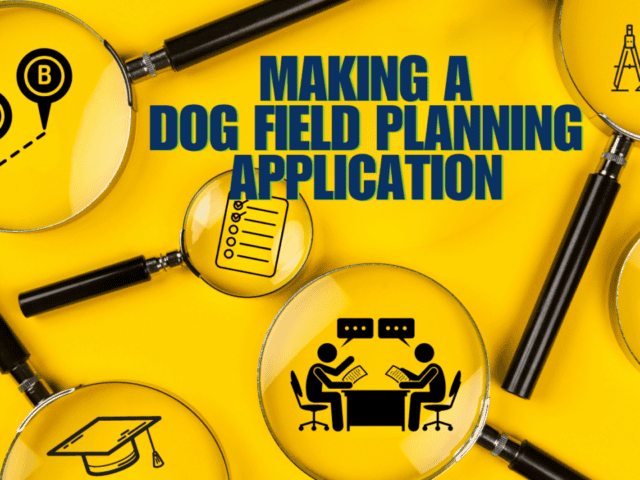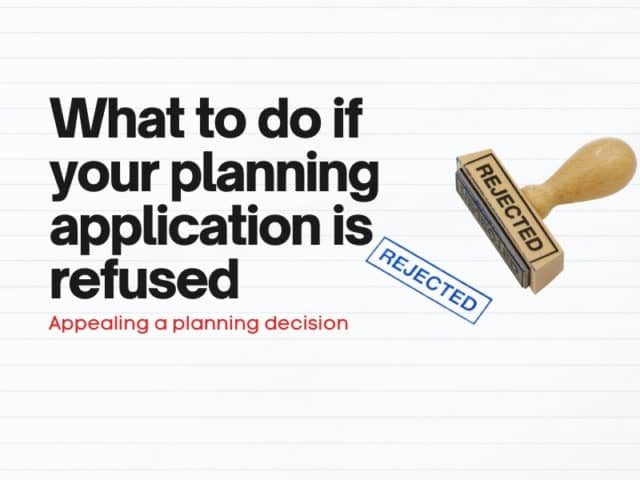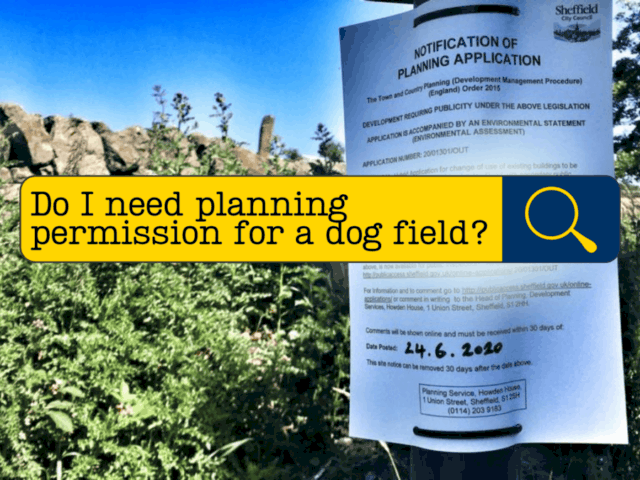If you are setting up a dog walking field in the UK or Ireland you will need to make a full planning application to your local planning authority. What you need to apply for is: ‘Change of Use: Sui Generis’.
Note: Most modern dog fields are over 1ha (2.4 acres) and therefore are also classed as a major development and this has a variety or implications in terms of making a successful planning application.
Now for less of the jargon!
I think making a planning application is possibly the most intimidating part of setting up a dog field. I thought it was about time someone pulled the curtains back to give a brief overview of the UK planning system when it comes to gaining permission for a secure dog field. It’s worth noting that the Scottish system is a little different (as is the Irish) but the system is similar.
An Introduction
Whether you’re making a full pre-emptive planning application (prior to starting work) or you’re making a retrospective application for a dog field, the principles and processes are the same – give or take.
Over the years there has been some speculation as to whether planning permission is really necessary for building a secure dog field business. Whilst those who queried it in the past had some legitimate cause to question it, this is no longer the case.
Planning officers are now well aware that a dog field requires a full planning application to be submitted. Many have backtracked in cases where they have given poor advice, leaving field owners exposed to enforcement notices.
It is also a relief to hear that for the most part, rural land agents and estate managers have also stopped peddling misinformation, stopping encouraging farmers and landowners to ‘suck it and see’ before making an application for a dog field.
If you want to know more about the need for planning permission and what you need to consider prior to making an application, read this.
Context – An Application On The Back Of A Fag Packet
Back in the olden days (that’s about 6 years ago in dog field years) there was some ambiguity around planning permission for dog fields but, perhaps worse than that, dog field applications around the country got treated completely differently.
For Example:
If you made an application in one district you might sail through the process in 56 days with barely a glance at your google-maps-scribbled site plan, whereas your neighbouring competition is jumping through hoops like a seal at a circus shelling out £1000s in surveys and assessments to get their planning permission into the system in the first place.
Whilst this is still the case in a few districts, most things have tightened up considerably and with that has come escalating costs and bureaucracy that you have to navigate in ballet shoes. Now we’re all pretty much in the same boat.
The purpose of this article isn’t to tear strips off the planning process but to pull back the curtains on what a planning application for a dog field looks like and highlight some of the potential trip hazards you can avoid with some careful planning.
A little caveat!
Here are a few things you need to be mindful of when reading this article:
- I am not a planning expert
- At British Dog Fields we have a team of planning experts across all the relevant disciplines (from chartered planning experts, acoustic surveyors and heritage bods to ecologists and transport specialists). Collectively I believe we have more experience than anyone in the country in handling dog field applications – we currently have a client waitlist so this is not a pitch!
- 3 years ago I would never have recruited a planning agent to submit a planning application – 3 years on I would never consider doing it alone
- We advise all clients of their options and make them aware of the risks associated with each planning strategy
- This advice is not comprehensive – the reason we don’t offer an ‘off the shelf’ DIY dog field planning application is that it’s not possible!
What Is The Purpose Of A Planning Application
I think you can break it down into these two defining principles:
- Do no harm
- Improve the place
That’s just my interpretation of the process but if you think of it through that lens, it’s a bit less daunting.
What Is The Process of Making a Planning Application for a Dog Field?
Let’s start with a Who’s Who and What’s What in the Planning Process:
| Term | Explanation |
|---|---|
| Planning Application | This term refers to all the elements combined, presenting your case to the planning authorities i.e. why planning permission should be given |
| Planning Authority | This is your local council. Sometimes called a district, borough or unitary council. They are the people who handle and decide on planning applications in your area. |
| Planning Officer | This is the individual allocated to your case and your point of contact |
| Statutory Consultees | These are the people who by law have to be consulted directly about your plans by the Planning Authority – this includes the Highway Authority, Flood Authority, The Environment Agency, Environmental Health and the local Parish Council (amongst others) |
| Consultees | These are people who, because we live in a democratic country, are informed of your plans and invited to comment. These are typically your neighbours and any other local groups |
| Planning Committee | If you’ve seen Clarkson’s Farm you’ll know what this is. In essence, it’s where you have to stand up in front of a panel of committee members (made up of a number of local councillors) and make your case. Usually, larger or more contentious applications are decided by a planning committee instead of the Planning Officer. The Committee hold your destiny in their hands and they vary from being a fantastic set up where the voice of reason and common sense prevails, to what can only be described as the polar opposite where nepotism and incentivised blinkers seem to rule. |
| The Planning Inspectorate | This is someone you don’t really want to face because it means you’re in the appeal process, asking someone to be more reasonable. The Planning Inspectorate is a Government Body that appoints an independent Planning inspector to review your case. The Inspector is responsible for reviewing your appeal and the buck stops with them |
| Planning Committee | If you’ve seen Clarkson’s Farm you’ll know what this is. In essence, it’s where you have to stand up in front of a panel of committee members (made up of a number of local councillors) and make your case. Usually, larger or more contentious applications are decided by a planning committee instead of the Planning Officer. The Committee hold your destiny in their hands and they vary from being a fantastic set up where the voice of reason and common sense prevails, to what can only be described as the polar opposite where nepotism and incentivised blinkers seem to rule. |
| Planning Consultant | This is a chartered Town Planner (not a surveyor, land agent or architect) who you can bring on board to help you through the planning process. Planning Consultants do not work for the Planning Authority rather utilise their expansive knowledge, experience and connections with Planning Officers to help you ultimately get planning permission. |
The Process of Submitting a Planning Application
Ugh. It’s boring but in a nutshell, the process is as follows:
You ‘The Applicant’ submit a planning application to the local planning authority. This is done digitally and comes at a cost of around £650 for a basic change of use which goes to the Council as a charge for processing your application.
As long as you have submitted the correct documentation, your application will be ‘validated’ – typically between 7 and 10 days from the date they acknowledge receipt.
The Council then has between 8 and 13 weeks (depending on the scale of the proposal) to do their bit and come to a decision. This involves consulting with a variety of stakeholders from neighbours to the highway authorities. Few authorities meet these deadlines and, if further assessments and surveys are required, this can be anything from a 5 to 9-month process.
Once a decision is made, you will be informed of your fate and, if approved, you can proceed happily with your dog field.
This is a very condensed version of events and of course, the outcome could go in a variety of different directions. If you want to know more about planning decisions you can find more in-depth information in our Membership which is open to both existing dog field owners and prospective owners here.
What You Need To Include In Your Planning Application:
- Design and Access Statement
- Site Plans
- Elevations (these are not always required)
- Surveys and Assessments
- Biodiversity Net Gain Documentation
The type and number of surveys and assessments that you may potentially need for your dog field planning application depends on many things. The designation of your land, its current use, its general environment and the location. Commonly surveys and assessments relate to ecology, traffic and noise, but can also include, flood risk assessments, heritage, individual species impact assessments such as badgers or bats, and a particular favourite of mine, the arborist report.
New to the dog field application process is the Biodiversity Net Gain Assessment, particularly for bigger sites, something that we have been preparing to navigate since rumours of its implementation began. How this affects you will depend on a number of factors, individual to your site.
All these can cause considerable delays in your application process and your planning consultant should be able to give you an indication of likely surveys and their costs before you make your application.
What Are The Costs Of Submitting A Planning Application For A Dog Field?
My favourite saying is ‘It depends’.
If you use a reputable and experienced planning consultant (we strongly advise you do so) then you have the initial outlay for their services, plus plans, surveys and assessments. You also have the mandatory planning authority fees.
Are you sitting comfortably?
A simple and straightforward planning application can cost around £4-5k. This is now rare for a number of reasons but we always advise people to allocate £10-15K for their application.
This accounts for additional survey expenses, any additional support (expert supporting evidence) and accounts for the appeal process should you have a battle with the authorities.
The average spend on a planning application of our clients in the last 12 months has been around £7,500 (including our support here from the British Dog Fields team) but we expect that average to rise with the new rules.
We have been made aware of applications that have gone into the £20,000s so we always advise clients to have a break-point figure in their head before they start this unpredictable process!
The good news: What’s worth knowing is that the dog field business has never been more buoyant, so whilst these upfront costs aren’t insignificant, they are also redeemable in a very short space of time as the return on investment of a dog field is very swift.
If you want to know more about how much a dog field can make, check out this article.
A Dog Field Planning Application Timeline
As we’ve already suggested – this is supposed to be 8-13 weeks – more often than not this is 5-7 months and our own application team is averaging 5.5 months from submission to approval.
There’s little you can do to influence the speed and getting ‘business-like’ about it with your planning officer rarely helps the situation.
The planning system is in total disarray and it is not uncommon for us to have conversations with planning officers who are so overworked that their departments are on the brink of collapse.
What Are The Outcomes?
You can have 3 outcomes:
- Approval with conditions
- Withdraw before the decision is made (by you, the applicant)
- Refusal
If you gain approval for your dog field the most likely outcome is that you will gain ‘approval with conditions’ – these conditions might range from, additional information you must provide prior to beginning work, to a simple restriction on lighting or opening hours, numbers of dogs or cars.
Some conditions need to be actioned or discharged before you do any work or start using the site. Once a condition is satisfied/discharged you get an additional decision from the planning authority confirming this. Where the planning authority asks for more information in a condition, this requires a small application that needs to be submitted (but at a much cheaper price).
The Planning Appeal Process
This is just a very brief overview of what an appeal is and how it works so you know what to expect if you end up at this stage with your dog field planning application.
The first thing I want to stress here is that going into an appeal unsupported by a professional is madness. You are now in a position where, if you want to get your application through, you are going to have to present a case based on facts, citing relevant planning policy, using precedent cases and quite frankly, this is no place for an amateur. We commonly see appeals fail because applicants believe that common sense and reason will prevail but unfortunately, it rarely works like that.
So what happens?
If your application is refused, the reasons for this will be given in the decision notice.
At the bottom of the decision notice you will see that you have the opportunity to appeal this decision if you think it is unfair, or you can provide further evidence or explanation as to how and why the decision given was unjust.
This is then considered by an independent Planning Inspector from the Planning Inspectorate who will draw a conclusion based on planning law and the policy framework and it is generally considered to be less dependent on interpretation and opinion and more on fact-based evidence.
What you can’t do in an appeal is change your application in any way. You are not supposed to make any changes to the design or scheme as a whole to now make it acceptable through the appeal process. To make changes you are required to submit an entirely new application to the planning authority again.
Why You Should Use A Planning Consultant And How To Choose One
There’s more to this than you might imagine.
Why Do You Need A Planning Consultant?
The process of gaining planning permission for a dog field has become increasingly complex over the last few years. Partly driven by changing legislation and an increased focus on what development is permitted in the countryside, but also because the amount of false information circulating has dramatically increased and you need someone to unpick that and keep a calm head.
In our opinion, navigating this increasingly fluid environment is the job of someone whose job it is to know – someone qualified, and whose responsibility it is to keep on top of the changes in the planning environment.
It’s a profession with a guilded charter and people spend years going through the education system to become a Planner which is worth thinking about because our head planner did more time in the formal education system than my neighbour who’s a surgeon.
How To Find A Planning Consultant
As someone who accidentally set up one of the most niche projects imaginable in British Dog Fields, I’m a big advocate of deep and specialist knowledge.
People who are so immersed in their tiny corner of a subject are in my opinion the weirdest folks on the planet and ones I really do like surrounding myself with.
So my Number 1 piece of advice on how to find a suitable planning consultant is to find one with a lot of experience in handling dog field applications in this dynamic time.
Number 2 on my list- look at their qualifications. There’s a big difference between a rural agent, surveyor or architect and a Chartered Planner. They all offer planning support services but there is a difference between their skill and understanding of the system – make sure you know what you’re buying
Number 3 – Don’t trust any planning consultant to do your dog field application who does not have a dog or has never done a dog field application before. I thought this partially in jest but now I actually think I might be deadly serious.
- Find someone with relevant experience
- Find someone with relevant qualifications
- Must have a dog

Always choose a Chartered Town Planner, with a wealth of experience in this industry who owns a dog. This is Stuart and Norman – Stuart heads up the ‘Dog Field Division’ of Evolve Planning and Design (our planning partners) and you can find out more about them here.
In Summary
Making a planning application for a dog field is not as straightforward as it once was. Between costly changes in terms of what information you need to provide as part of your application, and an inconsistent application of planning policy across the country, there’s a lot more to think about than any reasonable person would imagine.
Taking your time to get the design of the field is important and doing this in conjunction with an experienced planning consultant will not only lead to a better design but also a more viable planning application.
If you want to read more about dog field planning applications, see the articles below or if you want to talk to a member of our Specialist Dog Field Planning Team please click here to drop us an email or sign up for our newsletter about setting up a dog field at the bottom of the page.
Read More: Dog Fields and Planning Permission
If you are setting up a dog walking field you will need to make a full planning application to your local planning authority.
View moreIf your planning application is refused or unreasonable conditions are applied, you can appeal the decision. The success of that appeal is dependent on many things.
View moreIf you are planning to run a dog field as a commercial operation, renting your land to customers for the purpose of exercising dogs you will need consent from your local planning authority.
View more



